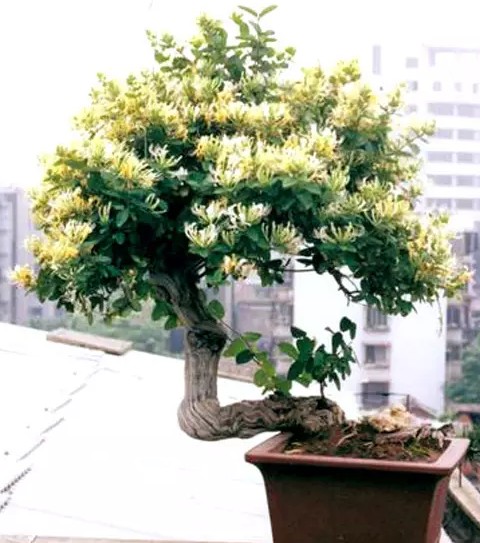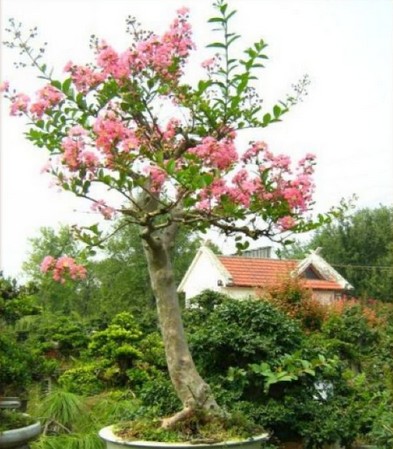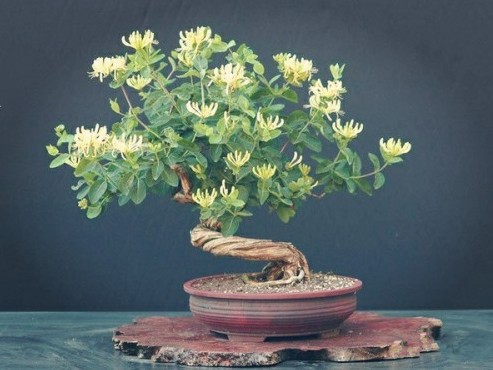Pruning skills of Honeysuckle Bonsai
Honeysuckle is strong in nature, it can take root as soon as the stem hits the ground, and the bare root can be transplanted, and the excavated old pile is easy to survive without fibrous root. From the beginning of pot planting, dwarfing, shaping and pruning was carried out and cultivated into thick, dry and short branches. During the growing period, remove the buds with exuberant growth, pick the hearts of the strong branches early, and keep them short when pruning. Through shaping and pruning, the pile scene of short shrub with short branches, uniform and dense branches and obvious layers can be changed from the winding type of vines to the short shrub type.

Honeysuckle has strong sprouting ability and pruning is very important. Cut off the thin branches and all kinds of branches that affect posture during the dormant period, and cut the sturdy branches properly. After the first flowering, heart picking can promote the second flowering. After the branches are pruned, the sprouting shoots are mostly flower branches, which can blossom when they grow to 10-20 cm.
1. Root pruning
The root system of honeysuckle stump dug out in the mountain or nursery is often very long, so don't rush to cut it short when you cultivate it, you should carefully observe the idea. The roots can often be shaped to replace dry roots, and then according to the size of the pot, cultivation needs, properly trim the roots, and then plant in the pot, do not bend the thick roots too hard or by a large margin to prevent breaking. In this way, after forming, it is intertwined and very pleasing to the eye.
2. Pruning branches
Honeysuckle wild in roadsides, hillside bushes or sparse forests, is a climbing plant, like winding, often in a spiral on nearby strips (such as trees, branches, etc.), often with leaves at the tail. Therefore, most of the old piles dug back are leafless and there are not many branches, only useless branches, weak branches, disease and insect branches need to be cut off, and the main branches need to be appropriately truncated according to proportion and shape. The tree stump dug in the nursery has been cultivated for many years, and its branches and leaves are more exuberant. It is necessary to properly cut the branches and leaves to make them dense and orderly, in line with nature and rich in painting.
3. Post-pruning treatment
Honeysuckle stumps are generally transplanted without soil masses. After pruning the roots and branches, it is best to soak them in water for 1 hour or 2 hours, let them absorb enough water, speed up the germination of new roots and buds, then smear the branch wound with white latex, dip the root wound with a new brush dipped in 0.3% potassium permanganate solution, and then plant it in a pot.
Time: 2019-06-13 Click:
- Prev

Watering method of crape myrtle bonsai
Crape myrtle bonsai is fond of light and is generally grown under sunny and well-ventilated conditions. But crape myrtle also likes to be moist and afraid of waterlogging, so watering should be appropriate. Too much watering will cause stagnant water, which will cause crape myrtle to rot and die. But if the water is not replenished in time, the growth will be suspended or withered due to lack of water.
- Next

Seedling raising technique of Honeysuckle Bonsai
Honeysuckle is used as park hedge, fence, balcony, flower gallery, flower rack and other three-dimensional greening in gardens, as well as ground cover materials for soil and water conservation, wind prevention and sand fixation. Honeysuckle not only can be planted on the ground, but also can be used as a potted ornamental. There are three culture methods of honeysuckle: seed culture, strip culture and cuttage culture.
Related
- Fuxing push coffee new agricultural production and marketing class: lack of small-scale processing plants
- Jujube rice field leisure farm deep ploughing Yilan for five years to create a space for organic food and play
- Nongyu Farm-A trial of organic papaya for brave women with advanced technology
- Four points for attention in the prevention and control of diseases and insect pests of edible fungi
- How to add nutrient solution to Edible Fungi
- Is there any good way to control edible fungus mites?
- Open Inoculation Technology of Edible Fungi
- Is there any clever way to use fertilizer for edible fungus in winter?
- What agents are used to kill the pathogens of edible fungi in the mushroom shed?
- Rapid drying of Edible Fungi

